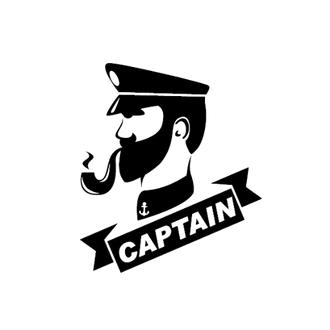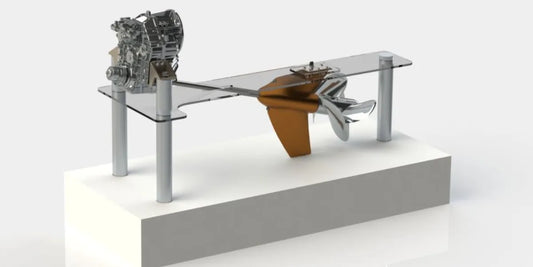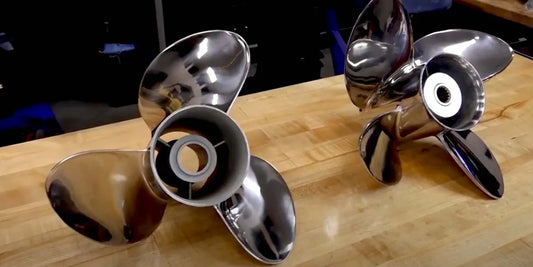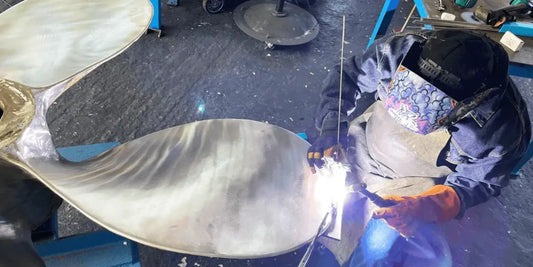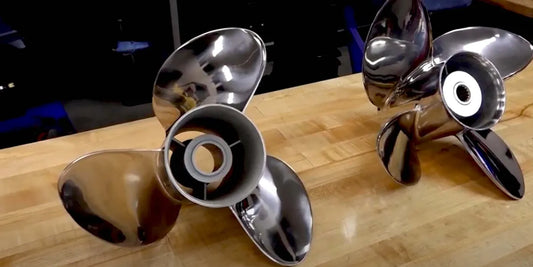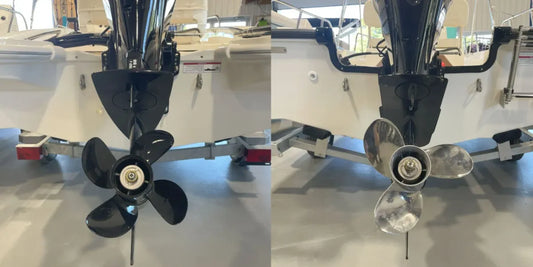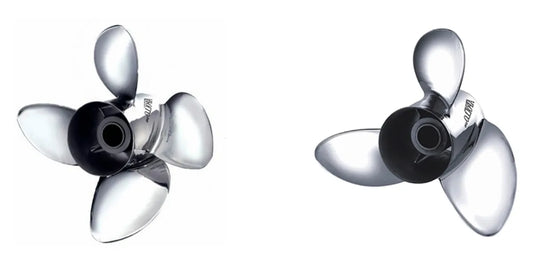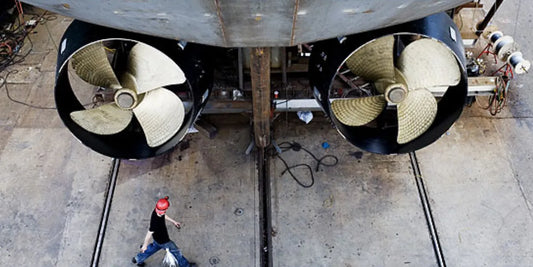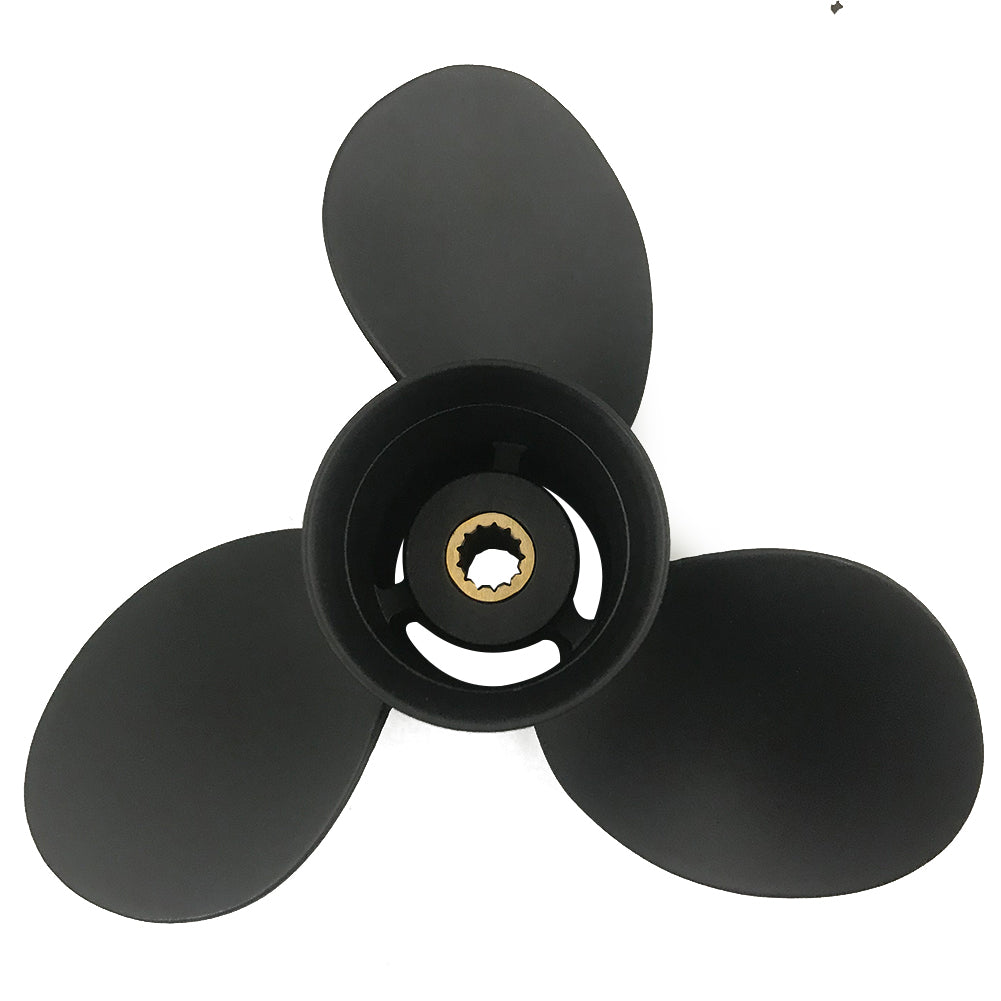The propeller choice is a pivotal yet often ignored parameter while considering the optimization of a performance vessel. A central subject of discussion for any true speed buff, weekend angler, or someone who puts fuel economy above all is the 4-blade versus 3-blade boat propeller debate. Each design's peculiarity caters to enhancing acceleration, top speed, maneuverability, and fuel economy in different ways. But how would you know which propeller would fit your boating adventures? This one walks you through the guts of 4-blade versus 3-blade propellers, and breaks down the differences to help you make an informed choice toward your water program. Before maximizing fuel efficiency or going for the exhilarating peak performance experience, this comparison must be considered.
Understanding Boat Propellers

The Basics of Propeller Design
A propeller, at its basic level, consists of a hub and two or more blades carefully shaped to provide thrust for propelling the vessel forward. Propeller design significantly impacts its efficiency, performance, and suitability for a particular type of boating. Some key considerations are the number of blades, pitch, diameter, and material.
Number of Blades: Generally, a propeller has three or four blades, each with pros and cons. While 3-blade propellers fare better in speed and top-end performance, 4-blade propellers offer smoother action, faster acceleration, and better stability in choppy waters.
Pitch and Diameter: Pitch is the distance the propeller would move forward in one revolution without slippage, directly affecting the speed and efficiency. A propeller with a higher pitch translates to the top speed, but there is a tradeoff in acceleration. A low pitch propeller will do better with thrust and acceleration, but less on the top speed. On the other hand, the diameter affects how much water is displaced, which is directly proportional to the thrust or power of a propeller.
Materials Used: Modern propellers are generally made of aluminium or marine-grade stainless steel. Aluminium propellers are lightweight, cheap, and suited for regular daily use. Stainless steel propellers cost more but are highly durable and offer superior performance in high-stress or harsh conditions.
Choosing the right propeller design, therefore, requires an understanding of these fundamentals and how to balance them with your engine and boating requirements. The right mixture offers better fuel economy, handling, and an overall enhanced boating experience.
Types of Boat Propellers
Depending upon blade count, design, and use, boat propellers are classified, each with unique benefits apt for particular uses. Given below are the main types of boat propellers and their functions:
Three-Blade Propellers: Three-blade propellers are the most commonly known type, balancing their qualities between speed and thrust. They do well for activities, generally boat-use-wise, fuel efficient, and relatively easy to handle. Its slick design causes less drag, making the prop suitable for recreational watercraft and small- to mid-sized crafts.
Four-Blade Propellers: Four-blade propellers tend to make for a more stable propeller with better thrust at comparatively slower speeds. You will want to go with them when you want to maintain power and control for water skiing, wakeboarding, or heavy loads. These propellers also enhance acceleration and are best for choppy waters.
Cupped Edge Propellers: As the name implies, this style of cupping occurs at the end of the blades, which helps to reduce slippage and increase water gripping. They get the boat going quite well and are suitable for high-performance or racing boats. They also provide anti-cavitation effects for extremely smooth operations at high speeds.
High-Pitch Propellers: High-pitch propellers are made to move over an area greater than other propellers in one rotation, favoring speed as the engine power is demanded farther. These propellers fit well with fast-moving lightweight crafts for those marine enthusiasts who want to maximize their top-end speed.
Low-Pitch Propellers: These propellers work best on the engine's thrust power and value rather than speed. They are great for towing work or powerboats when power and pull are more critical than velocity. It makes them easy to control and prevents engine overwork during high-demanding activities.
Clever Propellers (Cleaver Design): In racing boats, clever propellers with a special blade design cut the water with less resistance. These propellers are best for reaching top speed but are less practical for other purposes due to their narrow focus on high-speed performance.
Dual-Blade Propellers: A little less common but still used, these dual-bladed propellers are suitable for small, lightweight boats, such as dinghies or small sailboats. Maintenance is easy for these propellers, and they either go for a song, but it is a shame that they cannot muster the power and thrust that larger propellers would require.
The selection of the right propeller will mostly depend on your boat's peculiar requirements, such as weight, engine compatibility, and purpose. Understanding these variations will contribute to better performance, reduced engine strain, and better boating.
Blade-As-Water Propeller
The number, shape, and design of blades influence each other while affecting the performance of propellers. A standard three-bladed propeller is generally considered a very versatile choice concerning balancing speed, fuel economy, and handling smoothness, which makes it of great interest to recreational boat owners. Four-blade propellers, however, find their application in the heavier or larger boats by delivering better thrust and performance in rough waters.
Blade pitch and diameter are equally essential to attain an efficient power transfer that the engine generates into propulsion. At a higher pitch, the propeller takes less engine power to move the boat faster. These lower pitches will require higher torque for towing or other similar jobs. Furthermore, technological improvements in blade material, such as stainless steel and composites, have contributed to durability and precision, fulfilling various environmental and operational requirements.
Recent surveys also show that proper optimization of blade configuration may increase fuel economy for up to 10 percent with a fresh acceleration curve. This emphasizes matching the propeller blade specifications to the peculiar demands of any given vessel, be it speed, towing capabilities, or fuel efficiency.
3-Blade vs 4-Blade Propeller: Key Differences

Design and Structure Comparison
The different configurations of 3-blade and 4-blade propellers embody distinctions in structure, performance, field, and application suitability. A 3-blade propeller provides less surface area and, in turn, reduced drag and increased top speed, making it an ideal fit for vessels that focus on velocity and fuel efficiency. Conversely, a 4-blade propeller with a higher blade surface would give better thrust and smoother operation at lower speed levels in more challenging scenarios, heavier load conditions, or possibly in rough waters.
Recent analyses and investigations show that vibration noise reduction keeps 4-blades quieter and stabler, a cheesy concept given preference in recreational and fishing applications. 3-blades, however, are much appreciated for racing and sports crafts due to their ability to speed up faster and cruise efficiently. The ultimate choice between the two will rely on the vessel's requirements and aspects, such as weight, engine power, and what it is used for.
Performance Tests: Speed and Driving Efficiency
Speed and driving efficiency are essential parameters to measure as performance test cases for the correct propeller. Among the critical items to reckon with are pitch versus diameter versus blade count, as these determine, in unison, how well a propeller changes engine power into thrust. Conversely, a propeller with less pitch tends to allow increased low-speed maneuvering and acceleration, and hence would better suit water sports and towing. On the other hand, high-pitch propellers allow higher speed achievement and retention and best suit racing or open-water traveling.
The efficiency level also immediately affects fuel consumption and operational stability. Many cavitation and drag-reducing geometries ensure that these piracy activities may be most favorable, and this propeller ideology implements the anti-piracy principle, thereby promoting the fuel economy and providing a good operational life to the engine. For example, an aluminum or stainless steel propeller can give a more even performance when different competing loads are applied. Vessel weight, hull design, and water conditions may also be considered efficiency factors, hence the need for customized propeller choices against such parameters. Considering all these parameters to ensure neither speed nor efficiency compromises the durability of the propulsion system shall constitute a fair measurement.
Most Appropriate for Each Use
Understanding the chief qualities of each type is critical in determining the best propeller for the boat. Aluminum propellers are the cheapest for light to medium-duty uses, particularly for recreational applications and smaller crafts. They give satisfactory performance in calm waters and intangible for a user seeking a balance between price and performance.
Stainless steel propellers are proud of their durability and almost surgical precision, which would make a perfect choice for high-speed crafts or vessels running in a more testing environment. Since stainless steel is very rigid, it will allow better handling of a craft at high speed while resisting wear and tear in a rough environment or less frequent use. For demanding uses such as competitive racing and heavy marine operations, stainless steel will provide consistent efficiency for a long time while reducing the risk of damage caused by impact. This investment ensures to serve the worthy frequent boater or the pro for whom reliability outstrips the cost any day. Choosing an appropriate propeller should always closely correspond to the vessel's purpose, operating environment, and expected performance for the best efficiency and durability.
Speed Implications of 3-Blade and 4-Blade Propellers

Acceleration and Top Speed Analysis
To optimize their performance, one must judge the effect of the 3- and 4-blade options on their acceleration and top speed. A three-blade propeller can typically reach higher top speeds because of less drag and less surface area passing through the water. Their design is such that they aim at cutting the water as efficiently as possible and hence are the common choice for boats meant for top speed; for example, speedboats or racing configurations.
On the contrary, a four-blade propeller has better acceleration and handling characteristics in choppy or rough waters. This extra blade has more surface area, which increases thrust and allows smoother compromises during starts, stops, and turns. Such arrangements suit the priority applications of towing, fishing, or heavy-loaded vessels when stability, control, or fast planning are important.
From a data-driven perspective, various performance tests indicate that, in effect, 3-blade designs can provide increased top speeds between 3 and 5% over their 4-blade counterparts, whereas 4-blade propellers improve hole shot performance and operate consistently in arduous conditions. Hence, choosing the correct propeller means negotiating the trade-offs toward the particular plan of operation of the vessel and realizing the best performance in energy utilization.
Speed Outcome Influencing Factors
Several pertinent factors act upon the speed outcomes of a vessel equipped with either one or the other configuration of propellers. Propeller pitch is one such factor: it is the distance a propeller travels in one revolution; this pitches far into the distance of speed-making land. High can imply high speed top-end, while low generally implies more acceleration and maneuverability. Weight is considerably essential, as is load distribution aboard the vessel; however, when this increases, speed decreases, and the engine is also strained accordingly.
Hull design is another critical factor for hydrodynamically efficient hulls that make for a vessel that glides smoothly through water. Also important is how well the engine performs, whether it is well-maintained or not. So, if you want faster top speeds, ensure the engine runs well and never loses power. The environmental conditions include water current, wind resistance, and wave actions that may help or hinder a vessel's ability to attain peak speeds. Careful analysis and optimization of these variables will thus help a vessel operator retain the right combination of speed, efficiency, and performance.
Actual Speed Test Results
Example data from speed tests demonstrated up-front changes to a vessel's performance based on multiple factors. For example, high-performance speedboats tested with control limits in calm waters recorded peak speeds of 50 to 70 knots, varying with hull design and engine horsepower. The same vessels, however, lost their top speed by 10-20% in choppy conditions, depending on the waves' heights and the winds' resistance.
Comparatively speed-efficient commercial vessels designed for long-distance usually cruise at average speeds ranging from 15 to 25 knots, which defines operational efficiency over pure speed. Modern ships with hybrid propulsion yield constant speeds while mitigating fuel consumption by 30%, proving good performance and sustainability. Hence, these figures are good pointers on how different technologies under varying environmental parameters affect real-world vessel speeds.
Efficiency Considerations: Fuel and Power Usage

Understanding Propeller Efficiency
The propeller's efficiency influences the vessel's workability and fuel consumption. Several variables influence propeller efficiency: design, size, number of blades, pitch, and interaction between the propeller and hull. Thanks to advancements in computational fluid dynamics (CFD) and hydrodynamics testing, better designs can now be proposed that improve the niche's performance and reduce the cavitation phenomenon.
Optimized blade geometry can improve propulsion efficiency by about 10%, directly affecting fuel costs. Better materials, such as light composites or alloys that resist corrosion, may increase their life and minimize maintenance costs. Innovative designs like tip-loaded and contra-rotating propellers are now becoming another common option to decrease energy lost to thrust conversion.
Also, the propeller-rudder-hull interaction dictates the energy efficiency. Present research indicates that from a wake-adapted standpoint, propeller-rudder combinations can attain up to 7-8% efficiency increases to reduce drag and maximize ultimate output. This implies a great deal of consideration in integrated design and precision engineering for sustainable maritime operations.
Comparative Fuel Consumption Rates
Depending on the type of ship, its operating speed, or its propulsion efficiency, the fuel consumption of marine vessels can vary enormously. A bulk carrier tends to consume from about 25 up to 40 metric tons of fuel per day, depending on the size, type, and load; on the contrary, container ships optimized for speed and cargo efficiency can consume more than 100 metric tons during cruising speed for the largest vessels. Recent green technology improvements like LNG engines and hybrids seem to have a potential 20-30% reduction in fuel consumption compared with conventional marine diesel engines.
Efficiency is primarily affected by hull design, dynamic positioning system, and routing optimization software. Known for being big energy consumers, cruise ships are considered part of the equation for fuel savings between 5-10% with air lubrication. A slow steaming solution has been widely adopted, saving nearly 30% in fuel consumption by tanker and container fleets. These comparison insights reaffirm why innovation and strategic operations are crucial in reducing fuel consumption and environmental impact on the maritime industry.
Power Requirements for Different Blades
The power requirements for the various blade designs depend on the specific applications, their design configurations, and operating environments. For example, fixed-pitch propellers tend to perform well under conditions whereby vessels remain under a constant load and speed. They tend to require fewer varying powers, and they heavily rely upon the hull form being optimally designed to minimize fuel consumption and maximize thrust.
In contrast, controllable pitch propellers (CPPs) allow the blade angles to be adjusted literally within a wide range of power. Thus, they afford great power optimization opportunities in various sea conditions and varying load scenarios. This type of power application often results in fuel savings if applied to ships in mixed uses such as ferries and offshore support vessels; however, such efficiency improvements are traded off against slightly higher power requirements at baseline, that is, when compared to the simplest fixed pitch solutions.
Recent progress in design innovations has brought in winglets, or tip fins, for blade technology that has dramatically reduced vortex formation and drag, at least. This represents an enormous potential power-saving opportunity while maintaining a very high degree of aerodynamic/hydrodynamic operation. CFD simulation and real-world test results propose that roughly 5-7% efficiency gains could be translated directly to operational energy savings.
On the other hand, materials science achievements, such as lightweight composites, have also contributed considerably to power reduction for propulsion. These developments make the point clear that calculating power demand for various blade configurations calls for a well-thought-out, high-tech, and tailored approach.
Choosing the Right Propeller for Your Boat

Factors to Consider When Selecting a Propeller
Choosing the right propeller for your boat depends on several parameters considered before installation or purchase for ultimate performance, efficient fuel economy, and durability. Consider the following:
Engine Attachment: The horsepower and maximum RPM of the engine are major considerations in deciding on the proper propeller. The propeller needs to be spec-matched to the motor in order to transfer power effectively and not put undue strain on the motor.
Propeller Material: Aluminum or stainless steel materials are commonly used for making propellers. Stainless steel propellers are much stronger than aluminum ones, providing greater performance since aluminum tends to flex at high speeds or under high loads. A nice advantage aluminum has over steel propellers is that it is lighter in weight, and the price is more economical.
Number of Blades and Design: The number of blades used varies with performance. A 3-blade design should be used for faster speeds and better fuel efficiency, while 4 or 5 blades provide better handling and thrust for water skiing and heavier loads. Various blade designs with different rake angles or cupping will also alter the way your boat handles in rough water and how well it accelerates.
Pitch and Diameter: Pitch describes the theoretical movement of a proper propeller through water in one revolution. A lower pitch results in better acceleration with lower top speed, whereas a higher pitch provides maximum top-end speed. The diameter determines the amount of water being displaced; a large diameter serves for heavier boats, while a smaller diameter suits lighter and faster boats. The first critical point is striking the right balance between pitch and diameter that best satisfies your need for performance.
Application or Usage: This depends on how you anticipate using the boat. Propellers for fishing, cruising, and water sports boats will always have varying load, speed, and maneuverability specifications.
Preventing Cavitation and Ventilation: Having a well-selected geometry and size of blades greatly helps prevent cavitation, the appearance of bubbles on the blade surfaces, and ventilation, air ingress on the prop stream, both of which have detrimental effects on performance and efficiency.
By knowing these factors, boat owners or operators can make an informed decision about buying/selling or even just replacing the old propeller to augment the overall functionality of the vessel. It is highly suggested that one consult a marine technician or propeller expert to size precisely and get a recommendation tailored to the specific boat and operating scenario.
Specialized Recommendations for Various Boats
When selecting the right propeller for your boat, I always consider the type of boat and how it is intended to be used. In recreational boats like pontoons or ski boats, working towards smooth functioning and speed is usually essential. I'd usually recommend aluminum propellers for these boats. They are lightweight and cheap, giving an adequate compromise between durability and performance. If better acceleration and top speeds are wanted, one might consider a stainless-steel propeller. It has much better strength and efficiency.
For fishing boats or boats working in shallow waters, I recommend considering propeller strength and capacity to withstand impact. In this case, stainless-steel propellers are best, as they resist damage from rocks or other underwater hazards. Plus, when it comes to lower-speed trolling and maneuvering, it's equally important to pick a prop with a lower pitch so there's better control exerted and less strain put on the engine.
If you think of a larger boat, like a cruiser or a commercial one, fuel efficiency and load-carrying are essential. I suggest looking for a marine technician who can pick out the right blade design, diameter, and pitch combination to bear the boat's weight satisfactorily at the intended speed. The needs of each ship are pretty different, and with an expert helping you, you will ensure that they strike the perfect balance of performance, longevity, and fuel efficiency tailored for your specified application.
Common Mistakes that Should Be Avoided in Propeller Selection
From my experience, one of the gravest mistakes people make when selecting propellers is failing to adequately match the propeller to their specific boat engines and performance requirements. For most people, it is easy to assume a propeller with the same size and pitch as another boat will work on theirs. Yet, each vessel has different requirements; slight changes occur based on weight, engine type, and utilization. Putting on the wrong propeller can result in poor fuel economy, low speed, and eventually severe engine damage. I would always stress the importance of going by your engine's manufacturer's guidelines or checking with an expert to specify the best ones.
Another big mistake is failing to consider testing and tweaking the propeller chosen. People tend to forget that slight variations in propeller performance can be experienced upon changing water conditions, changes in the load, or sometimes even due to a change in altitude. Hence, choosing the prop "off the shelf" without considering how it reacts to realistic situations can ruin your entire project. Few trial runs will!
Lastly, boat owners do not perform regular propeller maintenance or inspections. In the general overview, minor imperfections or dings seem negligible; however, they drastically reduce performance and create imbalances. Worse, this imbalance will wear down on other parts, leading to expensive repairs. Keeping a healthy propeller in terms of maintenance and inspection helps foresee problems and extends the propeller's life. This has been a life-changing experience for me in maintaining my boats' efficiency and performance.
Reference Sources
- 3-Blade vs. 4-Blade Propeller - Michigan Wheel
- 3-Blade vs. 4-Blade Prop: What Are The Differences? - Reel Coquina Fishing
- 4 Blade vs 3 Blade Propeller - The Hull Truth Forum
- 3-Blade vs. 4-Blade Propellers - Boatsetter
- Four-Blade Propellers Versus Three: Pros and Cons - BoatTest
Frequently Asked Questions (FAQs)
What advantages does a 4-blade prop have over a 3-blade prop?
The 3-blade prop has several advantages over the 4-blade prop, even though the 4-blade prop offers various benefits. The additional blade increases the blade area, enhancing a boat's maneuverability at low speeds. This could suit recreational boats requiring faster hole shots for water skiing or other activities. Vibration is typically less with a 4-blade prop, translating to a smoother ride. The downside may be the top-end speed, which is slightly reduced compared to the 3-blade. The choice between the 3 and 4-blade propellers will ultimately depend on your usage of the boat and the performance you want.
How does the blade number affect fuel economy?
The number of blades on a propeller may affect the fuel economy considerably. Generally, the 4-blade prop is more fuel-efficient at lower RPMs because it can pull more steadily through the water. This becomes even more apparent when considering the prop slip, which might be reduced with a four-blade configuration. At the very high-speed end, however, a 3-blade is probably more efficient; at lower speeds, this increase in top speed means more fuel is burned out of the engines. So, it is essential to understand the trade-offs between a 3-blade and a 4-blade prop to get the best fuel usage on your boat.
Which type of boat benefits most by using a 4-blade propeller?
Four-blade propellers would benefit heavy boats that need thrust at low speeds. Ski and recreational boats benefit most from the extra blade area, allowing for better hole shots and faster acceleration. Moreover, boats made for towing or carrying heavy loads would gain from the pulling force exerted by a 4-blade prop. High-performance speedboats, however, may want to consider a 3-blade prop instead for top-end performance. Therefore, the decision primarily depends on the hull design and its intended use.
Will a 4-blade improve performance at WOT?
A 4-blade can improve WOT performance, particularly in acceleration and handling. Whereas 3-blade props can have higher top-end speeds, 4-blade props allow higher stability and high velocity control. The fourth blade helps hold the prop firmly through the water and thus reduces cavitation induced in sharp turns. But if your primary consideration is maxing out your top speed, pitch and diameter of the prop will need to be factored in as well because of their significant bearing on WOT performance.
Is it true that 3-blade propellers are best for high-speed-performance applications?
A 3-blade propeller will often be considered better for high-speed applications. This is mainly because a 3-blade design may usually have less drag and allow for higher rpms, thus contributing to faster top-end speeds. Equally important is that the odd number of blades means that 3-blade props make less turbulence in the water, thereby enhancing overall speed. On the other hand, 4-blade props would be more suitable whenever speed performances have to be complemented with strong low-speed performance, such as in towing and skiing. Ultimately, the prop's final decision will depend on your boat's particular requirements and activities to be carried out.
How can I decide between a three-bladed and a four-bladed prop for my hull design?
It depends on the boat's weight, intended usage, and desired performance characteristics. A lighter hull may do better with a 3-blade design, providing higher speeds and an efficient life. On the contrary, if your hull is a bit heavy or geared towards towing, 4-blade props might give you better acceleration and handling. Again, checking each prop's pitch and diameter to align with your engine's RPM could be quite beneficial. Try to swing by a prop guy or prop shop, and you will likely have the best proposition advanced for your very hull and needs.
